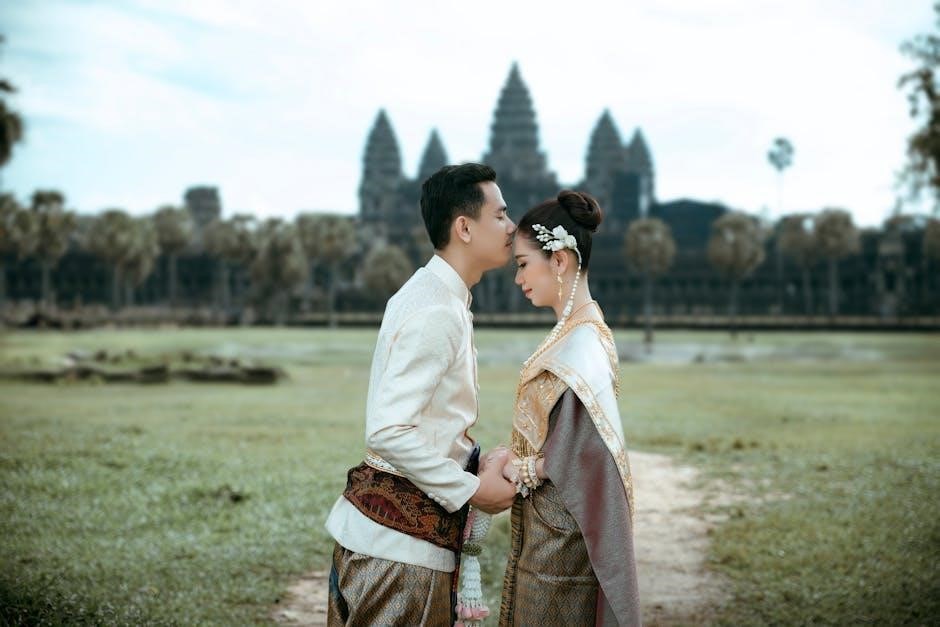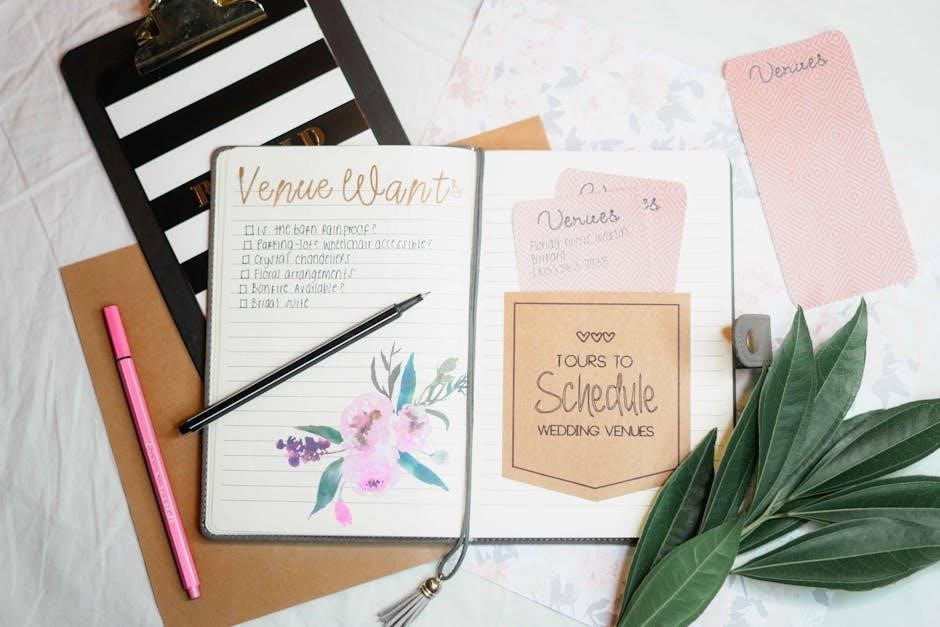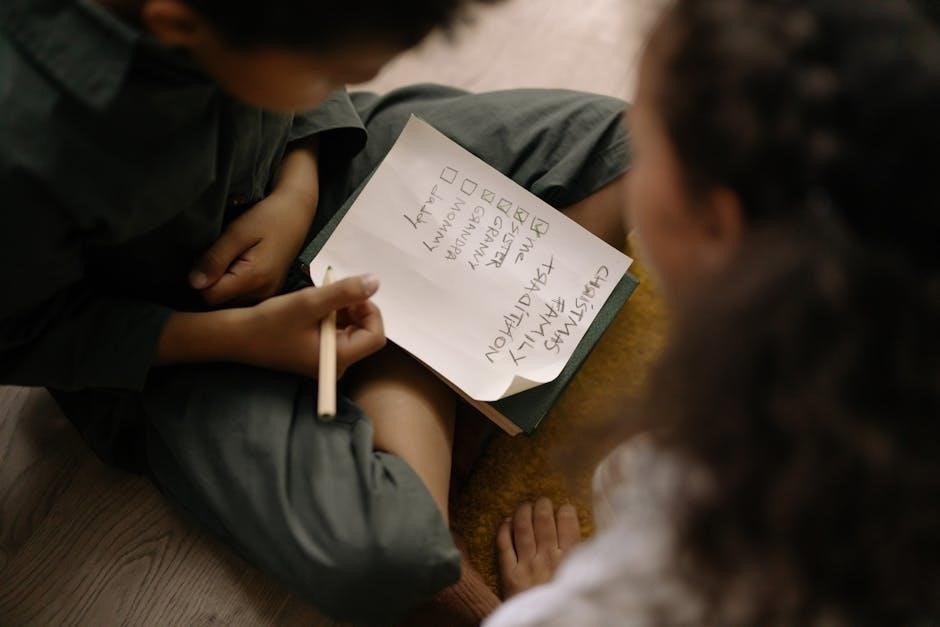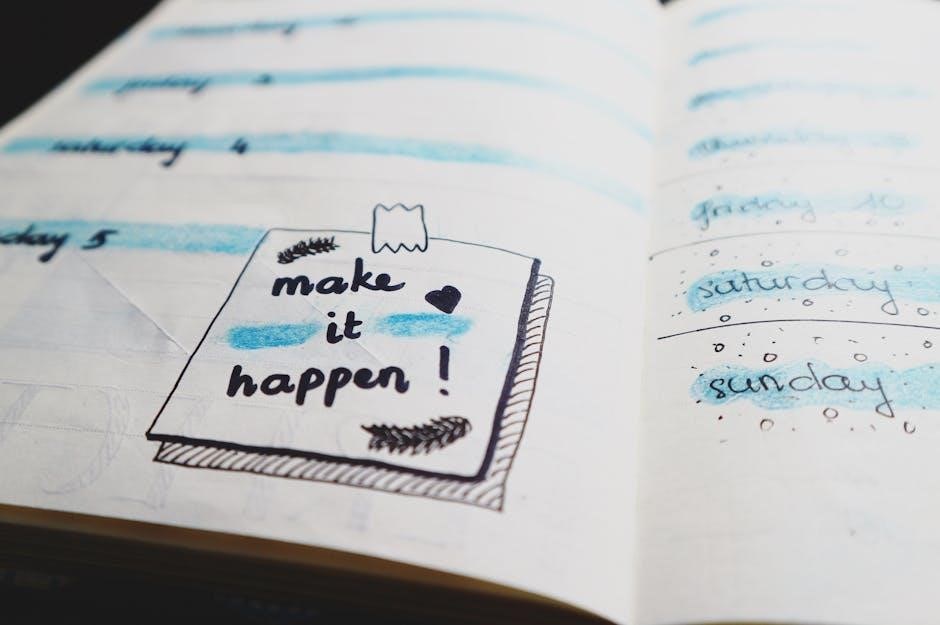
Wedding planning requires meticulous organization, starting with a detailed wedding planning to do list PDF. This essential tool helps couples streamline tasks, track progress, and ensure nothing is overlooked.
From vendor bookings to timeline management, a comprehensive checklist provides clarity and reduces stress. Popular platforms like Wedding Chicks offer customizable templates, making it easy to create a personalized guide.
A well-structured PDF checklist ensures all aspects, including budgets, venue details, and attire, are addressed timely. It’s a must-have resource for a seamless and joyful wedding experience.
1.1 Importance of a Wedding Planning Checklist
A wedding planning checklist is essential for managing tasks efficiently and ensuring nothing is overlooked. It helps couples stay organized, track deadlines, and maintain clarity throughout the process.
With a detailed wedding planning to do list PDF, couples can prioritize tasks, allocate responsibilities, and monitor progress. Popular resources like Wedding Chicks and bridal boutiques offer customizable templates.
This tool minimizes stress, ensures timely decisions, and guarantees a smooth execution of the wedding vision. It’s a vital resource for achieving a perfect and stress-free celebration.
1.2 Benefits of Using a Wedding Planning PDF
A wedding planning PDF offers versatility, accessibility, and convenience. It can be easily shared with vendors, printed, or accessed digitally. Many wedding planning PDFs include interactive features like checkboxes and hyperlinks, making task management simpler. They often combine checklists, budget trackers, and timelines in one document. This format ensures that all details are centralized, reducing the risk of miscommunication. A wedding planning PDF is a practical tool for staying organized and ensuring a seamless wedding preparation process.

Budgeting for the Wedding
Creating a realistic budget ensures financial control. Allocate funds to key areas like venue, catering, and attire. Track expenses to avoid overspending and maintain clarity throughout planning.
2.1 Creating a Realistic Wedding Budget
Start by determining the total budget, considering contributions from all sources. Allocate funds to key areas like venue, catering, and attire based on priorities. Research average costs locally to set realistic expectations. Decide on the guest list early, as it impacts expenses like food and venue size. Include a buffer for unexpected costs. Regularly review and adjust allocations to ensure alignment with priorities and financial capacity. This structured approach helps manage expenses effectively, ensuring a memorable wedding within budget constraints.
2.2 Allocating Funds to Different Aspects
Allocate funds by prioritizing key wedding elements. Typically, the venue and catering take the largest portion, followed by photography, attire, and entertainment. Assign percentages based on importance to you and your partner. For example, 40-50% for venue and food, 10-15% for photography, and 8-10% for attire. Adjust allocations to reflect your preferences while ensuring smaller details like decorations and favors are also accounted for. Flexibility is key to balancing priorities and budget constraints effectively.
2.3 Tracking Expenses with a Budget Tracker
Track wedding expenses using a budget tracker to monitor spending and stay organized. Regularly update the tracker to reflect actual expenditures, ensuring alignment with your allocated budget. This tool helps identify overspending and allows for timely adjustments. Use digital spreadsheets or apps for accessibility and ease of use. Maintaining a clear financial overview ensures transparency and helps you stay within your budget throughout the planning process.
Choosing the Wedding Date and Venue
Selecting a date and venue are crucial steps in wedding planning. Consider factors like season, guest capacity, and budget when making your decision.
3.1 Selecting a Date
Selecting a wedding date is a critical decision that impacts planning. Consider the season, day of the week, and personal significance. Popular dates may book quickly, so plan ahead. Check availability of key participants and venues. Weather, holidays, and local events can affect guest attendance. Create a shortlist of dates and prioritize based on preferences. Finalize the date early to secure vendors and send timely invitations.
3.2 Finding the Perfect Venue
Finding the perfect venue involves balancing aesthetics, practicality, and budget. Consider capacity needs, location accessibility, and amenities like parking and restrooms. Evaluate the atmosphere and whether it aligns with your wedding theme. Check for availability on your chosen date and inquire about restrictions. Visit potential venues in person to assess layout, lighting, and overall appeal. Compare costs and included services to make an informed decision that fits your vision and budget.

Planning the Wedding Party
Deciding the size and selecting attendants are crucial steps. Clearly define roles and responsibilities to ensure everyone understands their part. Guide them in preparing for the event.
4.1 Deciding on the Size of the Wedding Party
Determining the size of the wedding party involves balancing personal preferences, budget, and venue capacity. A smaller group simplifies planning and reduces costs, while a larger party adds to the celebration. Consider the number of attendants on both sides to maintain harmony. Ensure the size aligns with the overall wedding scale and style. Finalize the count early to coordinate attire and responsibilities efficiently.
4.2 Choosing Attendants and Their Roles
Selecting attendants involves choosing trusted friends and family to support you on your wedding day. Assign roles like Maid of Honor, Best Man, bridesmaids, and groomsmen based on their strengths and relationships. Clearly communicate expectations and responsibilities to ensure everyone understands their part. Consider the size of the wedding party and the balance between both sides. Finalize the list early to allow time for planning and coordination of their involvement in the ceremony and reception.
4.3 Selecting Attire for the Wedding Party
Selecting attire for the wedding party involves coordinating outfits that align with the wedding theme and color scheme. Choose dresses and suits that complement the bridal gown and are comfortable for all attendants. Consider fabric, season, and styles that flatter different body types. Schedule fittings to ensure proper sizing and make alterations as needed. Accessories like ties, shoes, and jewelry should unify the look. Finalize attire selections well in advance to avoid last-minute issues.

Hiring Vendors
Research and hire reputable vendors, ensuring they align with your wedding vision and budget. Negotiate contracts and confirm details to avoid last-minute issues.
5.1 Selecting a Photographer
Choose a photographer whose style aligns with your wedding vision. Review portfolios for consistency and quality. Ensure they specialize in weddings and have experience with your venue type. Discuss your preferences for candid, posed, or artistic shots. Compare pricing and packages, ensuring they fit your budget. Check reviews for reliability and professionalism. Confirm their availability and backup plans. Finally, ensure their contract outlines deliverables, timelines, and rights to the photos.
5.2 Choosing a Videographer
Selecting a videographer ensures your wedding memories are beautifully captured. Review samples to find a style that matches your vision—classic, cinematic, or documentary. Ensure they have experience with weddings and your venue type. Check reviews for reliability and professionalism. Discuss your expectations, such as key moments to focus on. Compare pricing and packages, ensuring they include coverage time, drone footage, or special effects if desired. Confirm their availability and backup equipment to avoid any issues on your day.
5.3 Hiring a Catering Service
Hiring a catering service is crucial for a memorable dining experience. Determine your budget and guest count to tailor options. Discuss menu preferences, including appetizers, main courses, and desserts. Schedule a tasting to ensure quality and flavor. Consider dietary restrictions and special requests. Review references and reviews to assess reliability. Confirm the serving style, such as buffet or plated meals. Ensure the caterer handles setup, cleanup, and staff. Finalize the contract with all details clearly outlined.
5.4 Booking a DJ or Live Band
Booking a DJ or live band enhances the celebration atmosphere. Decide between a DJ for varied playlists or a live band for a dynamic performance. Set a budget and research options, checking reviews. Ensure their style matches your wedding vibe. Discuss song preferences, including special dances. Confirm availability and equipment setup. Schedule a meeting or audition to assess their performance. Finalize the contract with timings, playlist details, and payment terms to ensure smooth entertainment on your wedding day.
5.5 Finding an Officiant
Finding the right officiant is crucial for a meaningful ceremony. Ensure they are ordained and legally authorized to perform weddings in your state. Consider their ceremony style—religious, secular, or personalized. Research local officiants, read reviews, and schedule meetings to discuss your vision. Confirm their availability and fees. Ensure they align with your ceremony tone and requirements. Secure your choice early to avoid last-minute stress. Discuss ceremony outlines and any personal vows or rituals you wish to include.

Planning the Ceremony
Craft a meaningful ceremony reflecting your love story. Decide on the order of events, readings, and rituals. Ensure legal requirements are met and personalized elements shine.
6.1 Ceremony Structure
Define the ceremony flow, starting with the processional, welcome remarks, readings, vows, and ring exchange. Include special rituals or cultural traditions. End with the pronouncement and recessional.
Ensure the structure reflects your personal style and honors meaningful customs. Coordinate with the officiant to finalize the order of events and timing for a seamless experience.
6.2 Choosing Ceremony Decor
Select decor that aligns with your wedding theme and color scheme. Consider flowers, aisle arrangements, and altar setups. Lighting, candles, and draping can enhance the ambiance. Personalize with meaningful elements like family heirlooms or cultural symbols. Ensure decor is proportionate to the venue size and complements the ceremony space. Balance aesthetics with functionality to maintain a focal point for the exchange of vows.

Planning the Reception
Plan the layout, seating, and ambiance. Organize speeches, toasts, and entertainment. Coordinate catering, bar services, and timing. Ensure a smooth flow for a memorable celebration.
7.1 Reception Layout
Plan the reception layout to ensure a smooth guest flow. Arrange tables, chairs, and dance floors strategically. Consider seating options like round or long tables. Assign seats for a formal setup. Ensure ample space for movement and accessibility to key areas like the buffet or bar. Decorate the space to reflect the wedding theme. Use lighting to create ambiance. Include a layout diagram in your wedding planning PDF for clarity. This ensures vendors and guests know the setup, avoiding last-minute chaos.
7.2 Planning Speeches and Toasts
Plan speeches and toasts to personalize the reception. Decide who will speak, such as the best man, maid of honor, or family members. Schedule the order of speeches to maintain flow. Provide guidelines for speakers to keep remarks concise and heartfelt. Include timing in the wedding planning PDF to ensure speeches fit seamlessly into the reception timeline. Prepare a toast script for the couple to thank guests and celebrate the occasion. Coordinate with vendors to ensure audio equipment is ready for speeches.
Wedding Attire
Plan wedding attire, including the wedding dress, groom’s suit, bridesmaid dresses, and accessories. Ensure styles align with the wedding theme and are comfortable for the day.
8.1 Selecting the Wedding Dress
Choosing the perfect wedding dress involves considering the wedding theme, body type, and personal style. Research different silhouettes, necklines, and fabrics to find a dress that flatters your figure and complements the venue. Schedule fittings at bridal salons to try on gowns and seek opinions from trusted friends or family. Ensure the dress is comfortable for a full day of celebrations. Don’t forget to plan for alterations and accessories like a veil or undergarments to complete the look.
8.2 Choosing Suits for the Groom
Selecting the groom’s suit involves matching the wedding’s theme and ensuring a polished appearance. Consider classic styles like black tie or formal suits in neutral tones. Tailoring is key for a perfect fit, so schedule a fitting well in advance. Customize details such as vests or ties to add personal flair. Coordinate with the bride’s dress to ensure harmony. Accessorize with cufflinks, belts, and shoes. Renting or buying depends on budget and preference. Ensure the suit reflects the wedding’s formality and style.
8.3 Accessories for the Wedding Day
Accessories play a crucial role in completing the wedding look. For the bride, a veil, jewelry, and a belt can enhance the dress. Hairpieces, gloves, and a clutch bag add elegance. The groom’s accessories include a tie, bow tie, or pocket square, paired with cufflinks, a belt, and polished shoes. Ensure all accessories match the wedding theme and color scheme. Don’t forget backup items like tissues and mints for the day. Accessories should complement, not overpower, the attire.
8.4 Shoes for the Wedding Party
Choosing the right shoes for the wedding party is essential for both style and comfort. The bride’s shoes should complement her dress, while the groom’s shoes should match his attire. Bridesmaids and groomsmen should wear shoes that coordinate with their outfits and the wedding theme. Ensure all shoes are comfortable for a long day of standing and dancing. Consider the venue terrain when selecting footwear. Break-in shoes beforehand to avoid discomfort. Have backups, like ballet flats, for later in the evening.

Invitations and RSVPs
Design and send invitations reflecting your wedding theme. Include essential details like date, venue, and RSVP deadline. Track responses using online tools or a spreadsheet for accuracy.
9.1 Designing Wedding Invitations
Design wedding invitations that reflect your theme and style. Include essential details like date, venue, time, dress code, and RSVP information. Choose wording that matches your event’s formality. Consider design elements such as colors, fonts, and graphics. Ensure the invitation is visually appealing and easy to read. Proofread for errors before printing. Digital invitations are also an option for convenience and cost savings. Make sure the design aligns with your wedding’s aesthetic and sets the tone for the celebration.
9.2 Sending Out Invitations
Send wedding invitations 8-10 weeks before the ceremony to give guests ample time to prepare. Include a pre-stamped RSVP card for convenience. Mail invitations via first-class postage for reliability. Consider sending digital invitations for a modern and eco-friendly option. Ensure all details are accurate before mailing. Track delivery for peace of mind. Follow up with guests who haven’t RSVP’d close to the deadline. Keep a record of sent invitations for easy reference and planning.
9.3 Tracking RSVPs
Track RSVPs using a spreadsheet, online tool, or wedding planning app. Set a clear deadline for responses. Follow up with guests who haven’t replied by the deadline. Use RSVP cards or digital responses for convenience. Maintain accurate records to finalize headcounts with vendors. Ensure all details are confirmed before the wedding day. This step ensures proper planning and avoids last-minute adjustments. Stay organized to manage guest numbers effectively.

Wedding Day Planning
Ensure a smooth wedding day by coordinating vendors, managing the party, and preparing for contingencies. Stay organized, delegate tasks, and enjoy the celebration effortlessly.
10.1 Creating a Wedding Day Timeline
A detailed wedding day timeline ensures everything runs smoothly. Include setup times, hair and makeup schedules, photo sessions, ceremony start, cocktail hour, reception timeline, speeches, cake cutting, and the grand exit. Share this timeline with vendors and the wedding party to keep everyone aligned. A well-planned timeline helps reduce stress and ensures all moments are captured. Consider including buffer times for unexpected delays. A sample timeline can be found in most wedding planning PDFs for reference.
10.2 Coordinating Transportation
Coordinating transportation ensures smooth arrivals and departures for the wedding party and guests. Arrange for limousines, shuttles, or rideshares. Plan pickup and drop-off times for vendors, attendants, and out-of-town guests. Designate drivers or book professional services. Share the transportation schedule with everyone involved. Consider parking options for guests and venue accessibility. A well-coordinated plan prevents delays and reduces stress, ensuring the day flows seamlessly.

Legal and Administrative Tasks
Finalize marriage license applications, complete name changes, and prepare necessary documents. Ensure all legal requirements are met to validate the union officially, avoiding last-minute issues.
11.1 Obtaining a Marriage License
Research and gather required documents, such as identification, birth certificates, and divorce papers if applicable. Visit the local clerk’s office to submit the application, pay the fee, and receive the license. Processing times vary, so apply well in advance of the wedding date to ensure everything is finalized. This legal step is crucial for the marriage to be officially recognized and recorded.
11.2 Name Change Process
Research the legal steps for changing your name after marriage. Update your name on the marriage license and notify the Social Security Administration to obtain a new Social Security card. Next, update your name with the DMV, banks, employers, and healthcare providers. This process can take time, so start early to ensure all documents reflect your new name before the wedding day. Proper documentation is essential for a smooth transition.

Miscellaneous Details
Finalize wedding favors, select wedding rings, plan the honeymoon, and prepare an emergency kit with essentials like bobby pins, tissues, and mints for the big day.
12.1 Wedding Favors
Wedding favors are small tokens of appreciation for guests, reflecting the couple’s style or wedding theme. Choose items like personalized candles, custom coasters, or plants for a meaningful touch. Consider practicality and budget, ensuring favors align with the overall aesthetic. DIY options, such as homemade treats or photo frames, add a personal feel. Present them elegantly, perhaps with a note of thanks, to create lasting memories of your special day;
12.2 Wedding Rings
Wedding rings symbolize eternal love and commitment, making them a heartfelt part of the ceremony. Choose rings that reflect personal style, with options like gold, platinum, silver, or titanium. Consider engravings or diamonds for added sentimental value. Set a budget and allocate funds accordingly. Ensure the rings fit perfectly by trying them on beforehand. Purchase insurance to protect this meaningful investment. Selecting wedding rings is a intimate decision, reflecting the couple’s promise to one another.
12.3 Honeymoon Planning
Plan your honeymoon to celebrate your wedding bliss. Choose a destination that matches your preferences and budget. Research activities and experiences to make it memorable. Book accommodations and flights in advance to secure the best options. Allocate funds specifically for the honeymoon in your budget. Consider travel insurance for unexpected changes. Ensure all passports and visas are up to date. Share your plans with a trusted friend or family member for emergencies. Enjoy this special time to relax and celebrate your new life together.
12.4 Wedding Day Emergency Kit
A wedding day emergency kit is essential for handling last-minute issues. Include items like bobby pins, tissues, safety pins, breath mints, and a small sewing kit. Add a clear nail polish for stocking runs and pain relievers for headaches. Pack wet wipes, a portable charger, and extra makeup supplies. Assign a trusted friend or family member to manage the kit. This ensures quick solutions to unexpected problems, keeping your wedding day stress-free and enjoyable.